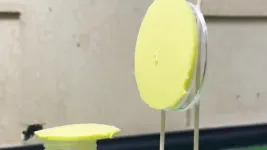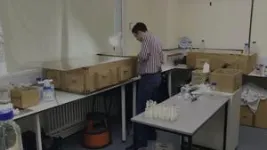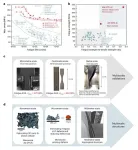(Press-News.org) Research has found that bumblebees make foraging choices to collect the most sugar from flowers in the shortest time – even if that means using more energy in the process – to provide an immediate energy boost for the colony.
A new study investigating nectar drinking in one of the most common bumblebees in the UK, Bombus terrestris, has found that when foraging they maximise the amount of nectar sugar they take back to the colony each minute.
To make their choices, the bumblebees trade off the time they spend collecting nectar with the energy content of that nectar. This means they will forage to collect nectar that’s hard to access – but only if the sugar content of that nectar makes it worth doing so.
This big-and-fast approach contrasts with honeybee foraging: honeybees make their decisions by optimising their individual energy expenditure for any nectar they collect. This more measured approach should prolong the honeybee’s working life.
“As they forage, bumblebees are making decisions about which nectar sources will give the greatest immediate energetic return, rather than optimising the energy efficiency of their foraging,” said Dr Jonathan Pattrick, joint first author of the report, who started the research while in the University of Cambridge’s Department of Plant Sciences.
Pattrick, now based at the University of Oxford, added: “Our results allow us to make predictions about the sorts of flowers the bumblebees are likely to visit, which could inform the choice of which flowers to plant in field margins to support these important pollinators. It’s also relevant to crop breeders who want to make varieties that are ‘better’ for bumblebees.”
The results are published today in the journal iScience.
Over six months the researchers made 60,000 behavioural observations of the bumblebees, allowing them to precisely estimate bumblebee foraging energetics. It was painstaking work: each bumblebee in the study was watched for up to eight hours a day without a break.
The team used vertically and horizontally oriented artificial flowers, with surfaces that were slippery and difficult for the bumblebees to grip.
A custom computer program allowed the team to measure the split-second timing as the bumblebees flew between the artificial flowers and foraged from them. This meant the team could track how much energy the bumblebees spent flying as well as how much they collected when drinking, and identify how the bumblebees decided whether to spend extra time and energy collecting high-sugar nectar from slippery flowers, or take the easier option of collecting lower-sugar nectar from flowers they could land on.
“It’s amazing that even with a brain smaller than a sesame seed, bumblebees can make such complex decisions,” said Dr Hamish Symington in the University of Cambridge’s Department of Plant Sciences and joint first author of the report.
He added: “It’s clear that bumblebee foraging isn’t based on a simple idea that ‘the more sugar there is in nectar, the better’ – it’s much more subtle than that. And it highlights that there’s still so much to learn about insect behaviour.”
Individual bumblebees were given one of three tests. In the first test, the nectar on both vertical and horizontal artificial flowers had the same amount of sugar, and the bumblebees made the obvious choice to forage from the horizontal flowers, rather than spend extra time and energy hovering at the vertical ones. In the second test, the nectar on the vertical flowers was much more sugary than the nectar on the horizontal flowers, and the bumblebees chose to drink almost exclusively from the vertical flowers.
In the third test, the vertical flowers offered nectar which was only slightly more sugary than the horizontal flowers. This created a situation in which the bumblebees had to make a trade-off between the time and energy they spent foraging and the energy in the nectar they were drinking – and they switched to feeding from the horizontal flowers.
The results show that bumblebees can choose to spend additional time and energy foraging from hard-to-access nectar sources – but only if the reward is worth it.
Bumblebees drink nectar from flowers, then offload it in their nest – by regurgitation – for use by other bumblebees in the nest. Unlike honeybees, bumblebees only store a small amount of nectar in the nest, so they need to make the most of every opportunity to forage.
END
Getting maximum calories in shortest time is the priority for bumblebees
2023-10-24
ELSE PRESS RELEASES FROM THIS DATE:
Incidence and transmission of SARS-CoV-2 in child care centers after COVID-19 vaccines
2023-10-24
About The Study: In this examination of SARS-CoV-2 incidence and transmission in child care centers (CCCs) and students’ households, transmission within CCCs and from children infected at CCCs into households was low in this study that included 83 children in 11 CCCs. These findings suggest that current testing and exclusion recommendations for SARS-CoV-2 in CCCs should be aligned with those for other respiratory viruses with similar morbidity and greater transmission to households.
Authors: Timothy R. Shope, ...
Neurodevelopmental outcomes among offspring exposed to corticosteroid and B2-adrenergic agonists in utero
2023-10-24
About The Study: The results of this study of 91,460 mother-offspring pairs found no association between in utero corticosteroid and β2-adrenergic agonist exposure and offspring neurodevelopmental outcomes, regardless of the timing of exposure. Despite the limitations and low power of the study, the findings suggest that corticosteroids and β2-adrenergic agonists are safe for pregnant individuals with asthma and the neurodevelopment of their offspring.
Authors: Abir Nagata, Ph.D., of Osaka University in Osaka, Japan, and Toshio Masumoto, Ph.D., of Tottori University ...
Child care centers unlikely source for COVID-19 transmission, study finds
2023-10-24
Children in child care centers are not spreading COVID-19 at significant rates to caregivers or other children at the center, nor to their households, according to a study led by University of Pittsburgh School of Medicine and UPMC Children’s Hospital of Pittsburgh pediatrician-scientists and published today in JAMA Network Open.
The findings suggest that recommendations to test symptomatic children for SARS-CoV-2, the virus that causes COVID-19, and keep positive children home from child care for prolonged periods can be revised to align with those for other serious ...
Pew funds 6 teams to advance cutting-edge biomedical research
2023-10-24
PHILADELPHIA—The Pew Charitable Trusts announced today the six pairs of researchers who will make up its 2023 class of Innovation Fund investigators.
These 12 acclaimed scientists—all alumni or advisors of Pew’s biomedical programs in the United States and Latin America—will partner on interdisciplinary research projects exploring key questions in human biology and disease. Combining the researchers’ expertise in topics ranging from neuroscience and immunology to cancer biology, these collaborations will help boost scientific discovery and improve human health.
“An interdisciplinary approach to research is critical to uncovering scientific breakthroughs ...
Givers to crowdfunding campaigns enjoy vicarious success
2023-10-24
Why would someone decide to give their money to help a stranger bring a creative project to life?
Recent research has found that backers of crowdfunding projects participate, in part, because of a sense of indirect success and the feeling that they are contributing to something bigger.
Crowdfunding — raising money for a new venture by collecting small amounts from many people — is most often done online, and messaging on the most popular sites reinforces the perception of a more democratic market.
But the reality is a bit ...
Climate report: ‘Uncharted territory’ imperils life on Earth
2023-10-24
CORVALLIS, Ore. – An international coalition of climate scientists says in a paper published today that the Earth’s vital signs have worsened beyond anything humans have yet seen, to the point that life on the planet is imperiled.
William Ripple, a distinguished professor in the Oregon State University College of Forestry, and former OSU postdoctoral researcher Christopher Wolf are the lead authors of the report, and 10 other U.S. and global scientists are co-authors.
“Without actions ...
World Scientists' Climate Report highlights perils as Earth enters "uncharted territory"
2023-10-24
In a year marked by wildfire, catastrophic flooding, and deadly weather events, an international team of scientists has updated its influential 2019 World Scientists Warning of a Climate Emergency report, which has been cosigned by over 15,000 scientists representing 163 countries. According to the team, “life on planet Earth is under siege” and “we are now in uncharted territory.”
Writing in the journal BioScience, William Ripple, a distinguished ...
Blood test detects tumors early in families with cancer
2023-10-24
Researchers from The Hospital for Sick Children (SickKids), the Ontario Institute for Cancer Research (OICR) and University Health Network (UHN) have demonstrated that by analyzing patients’ blood samples, they are able to detect cancer earlier in individuals with Li-Fraumeni syndrome, an inherited condition with an almost 100 percent life-time risk of developing cancer.
The research, led by Drs. Trevor Pugh and Raymond Kim at Princess Margaret Cancer Centre, UHN and OICR and Dr. David Malkin at SickKids, has been published in Cancer Discovery. The study, which was funded primarily ...
Boston Children’s Hospital receives a contract of up to $9 million from NIH to improve flu vaccines
2023-10-24
Flu season is upon us, and existing vaccines are only ~40-60% effective at reducing the risk of serious illness. While any level of protection against influenza viruses is better than none, there remains a lot of room for improvement of future vaccines. The Precision Vaccines Program (PVP) at Boston Children’s Hospital was awarded a Vaccine Adjuvant Development Program contract (75N93023C00040) from the National Institutes of Health (NIH)/National Institute of Allergy and Infectious Diseases (NIAID) that can extend up to 5 years and $9 million, ...
CityU joint research creates 3D-printed aluminium alloy with unprecedented fatigue resistance
2023-10-24
It is estimated that over 80% of engineering failures are due to material fatigue, so the fight against metal fatigue failures continues, as this is a key parameter for lightweight structures for all mechanical systems, such as aircraft, automobile and energy-production systems. Recently, joint research by City University of Hong Kong (CityU) and Shanghai Jiao Tong University achieved a breakthrough by creating an aluminium alloy with unprecedented fatigue resistance using advanced 3D printing techniques. ...






